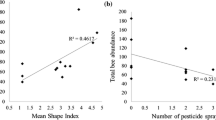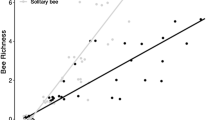Abstract
Although grapevine is a crop that produces fruit without insect pollination, vineyards may provide resources for bees and other pollinators. Flower resources such as pollen and nectar are provided by the vine plants as well as other flowering plants including cover crops grown between the vine rows. Little is known about how management and landscape context affects bee communities in pollinator-independent crop systems such as grapevine. This study investigates the effect of organic versus conventional management on bee species richness and abundance in vineyards in Italy and South Africa both having a Mediterranean climate. In each country, six pairs of organic and conventional vineyards were studied in simplified and complex agricultural landscapes. A total of 433 bee individuals from 25 species and 1049 individuals from 15 species were recovered in pan traps from Italy and South Africa respectively. Bee abundance showed region specific response to the effects of vineyard management. Flowering plants and proportion of uncultivated land mediated differences in bee abundance. Higher flowering plant species richness and flower density were found in organic vineyards compared to conventional vineyards in South Africa but these flowering plant indices were not significantly different between the two vineyard management types in Italy. This emphasizes the necessity for local and region specific studies for informing conservation, as even in the same crop system with a similar climate, the effects of farm management differed between countries.




Similar content being viewed by others
References
Bengtsson J, Ahnström J, Weibull AC (2005) The effects of organic agriculture on biodiversity and abundance: a meta-analysis. J Appl Ecol 42:261–269
Bossard M, Feranec J, Otahel J (2000) CORINE land cover technical guide-Addendum 2000. Technical Report No. 40. European Environment Agency, Copenhagen
Brittain CA, Vighi M, Bommarco R, Settele J, Potts SG (2010a) Impacts of a pesticide on pollinator species richness at different spatial scales. Basic Appl Ecol 11:106–115
Brittain CA, Bommarco R, Vighi M, Settele J, Potts SG (2010b) Organic farming in isolated landscapes does not benefit flower-visiting insects. Biol Conserv 148:1860–1867
Campbell JW, Hanula JL (2007) Efficiency of Malaise traps and colored pan traps for collecting flower visiting insects from three forested ecosystems. J Insect Conserv 11:399–408
Carvalheiro LG, Seymour CL, Veldtman R, Nicolson SW (2010) Pollination services decline with distance from natural habitat even in biodiversity rich areas. J Appl Ecol 47:810–820
Carvell C, Meek WR, Pywell RF, Nowakowski M (2004) The response of foraging bumblebees to successional change in newly created arable field margins. Biol Conserv 118:327–339
Conservation International (2016) Cape Floristic Region https://www.conservation.org/where/priority_areas/hotspots/africa/Cape-Floristic-Region/Pages/default.aspx Accessed 1 June 2016
Cowling RM, Rundel PW, Lamont BB, Arroyo MK, Arianoutsou M (1996) Plant diversity in mediterranean-climate regions. Trends Ecol Evol 11:362–366
Critical Ecosystem Partnership Fund (2001) Ecosystem profile: The Cape Floristic Region, South Africa. http://www.cepf.net/Pages/default.aspx Accessed 1 June 2016
Eardley C. Kuhlmann M. Pauly A (2010) The bee Genera and Subgenera of sub-Saharan Africa, vol 7. Belgian Development Cooperation, Brussels, p 145
Ekroos J, Heliölä J, Kuussaari M (2010) Homogenization of lepidopteran communities in intensively cultivated agricultural landscapes. J Appl Ecol 47:459–467
Entling W, Schmidt MH, Bacher S, Brandl R, Nentwig W (2007) Niche properties of 587 Central European spiders: shading, moisture and the evolution of the habitat niche. Glob Ecol Biogeogr 16:440–448
FAO (2014) Food and Agriculture Organization of the United Nations Statistics Division. http://faostat3.fao.org/home/E. Accessed 1 June 2016
Gaigher R, Samways MJ (2010) Surface-active arthropods in organic vineyards, integrated vineyards and natural habitat in the Cape Floristic Region. J Insect Conserv 14:595–605
Goldblatt P, Manning JC (2002) Plant diversity of the Cape region of Southern Africa. Ann Mo Bot Gard 89:281–302
Goulson D, Hughes WOH, Derwent LC, Stout JC (2002) Colony growth of the bumblebee, Bombus terrestris, in improved and conventional agricultural and suburban habitats. Oecologia 130:267–273
Heller NE, Zavaleta ES (2009) Biodiversity management in the face of climate change: A review of 22 years of recommendations. Biol Conserv 142:14–32
Hole DG, Perkins AJ, Wilson JD, Alexander IH, Grice PV, Evans AD (2005) Does organic farming benefit biodiversity? Biol Conserv 122:113–130
Holzschuh A, Steffan-Dewenter I, Kleijn D, Tscharntke T (2007) Diversity of flower-visiting bees in cereal fields: effects of farming system, landscape composition and regional context. J Appl Ecol 44:41–49
Kehinde TO, Samways MJ (2012) Endemic pollinator response to organic vs. conventional farming and landscape context in the Cape Floristic Region Biodiversity hotspot. Agric Ecosyst Environ 146:162–167
Kehinde TO, Samways MJ (2014) Insect-flower interactions: network structure in organic versus conventional vineyards. Anim Conserv 17:401–409
Kennedy CM, Lonsdorf E, Neel MC, Williams NM, Ricketts TH, Winfree R, Bommarco R, Brittain C, Burley AL, Cariveau D, Carvalheiro LG, Chacoff NP, Cunningham SA, Danforth BN, Dudenhöffer J-H, Elle E, Gaines HR, Garibaldi LA, Gratton C, Holzschuh A, Isaacs R, Javorek SK, Jha S, Klein AM, Krewenka K, Mandelik Y, Mayfield MM, Morandin L, Neame LA, Otieno M, Park M, Potts SG, Rundlöf M, Saez A, Steffan-Dewenter I, Taki H, Viana BF, Westphal C, Wilson JK, Greenleaf SS, Kremen C (2013) A global quantitative synthesis of local and landscape effects on wild bee pollinators in agroecosystems. Ecol Lett 16:584–599
Kremen C, Williams NM, Thorp RW (2002) Crop pollination from native bees at risk from agricultural intensification. Proc Natl Acad Sci USA 99:16812–16816
Kuhlmann M (2005) Diversity, distribution patterns and endemism of southern African bees (Hymenoptera: Apoidea). In Huber BA, Sinclair BJ, Lampe K-H (eds) African biodiversity: molecules, organisms, ecosystems. Proceedings of the 5th International Symposium on Tropical Biology. Museum Koenig, Springer, The Netherlands, p 167–172
Kuhlmann M (2009) Patterns of diversity, endemism and distribution of bees (Insecta: Hymenoptera: Anthophila) in southern Africa. S Afr J Bot 75:726–738
Linder HP, Johnson SD, Kuhlmann M, Matthee CA, Nyffeler R, Swartz ER (2010) Biotic diversity in the South African winter-rainfall region. Curr Opin Environ Sustain 2:109–116
Manella M (2004) Valutazionesito—specificadelrischioecotossicologico per l’ecosistema terrestrederivantedall’impiego di prodottifitosanitari. Masters dissertation, Universitàdeglistudi di Milano Bicocca
Mayer C (2005) Does grazing influence bee diversity? African biodiversity: molecules, organisms, ecosystems. In Proceedings of the 5th International Symposium on Tropical Biology, Museum Koenig, Bonn, pp 173–179
Myers N, Mittermeier RA, Mittermeier CG, Da Fonseca GAB, Kent J (2000) Biodiversity hotspots for conservation priorities. Nature 403:853–858
Olson DM, Dinerstein E (2002) The global 200: Priority ecoregions for global conservation. Ann Mo Bot Gard 89:199–224
Potts SG, Biesmeijer JC, Kremen C, Neumann P, Schweiger O, Kunin WE (2010) Global pollinator declines:trends, impacts and drivers. Trends Ecol Evol 25:345–353
Puig-Montserrata X, Stefanescua C, Torrea I, Paletd J, Fàbregasb E, Dantarta J, Arrizabalagaa A, Flaquera C (2017) Effects of organic and conventional crop management on vineyard biodiversity. Agric Ecosyst Environ 243:19–26
R Development Core Team (2017) R: A language and environment for statistical computing. R Foundation for Statistical Computing, Vienna, ISBN 3-900051-70-0
Reader T, Macleod I, Elliott PT, Robinson OJ, Manica A (2005) Inter-order interactions between flower- visiting insects: foraging bees avoid flowers previously visited by hoverflies. J Insect Behav 18:51–57
Roschewitz I, Gabriel D, Tscharntke T, Thies C (2005) The effects of landscape complexity on arable weed species diversity in organic and conventional farming. J Appl Ecol 42:873–882
Rouget M, Richardson DM, Cowling RM, Lloyd JW, Lombard AT (2003) Current patterns of habitat transformation and future threats to biodiversity in terrestrial ecosystems of the Cape Floristic Region, South Africa. Biol Conserv 112:63–85
Rundlöf M, Smith HG (2006) The effect of organic farming on butterfly diversity depends on landscape context. J Appl Ecol 43:1121–1127
Rundlöf M, Edlund M, Smith HG (2010) Organic farming at local and landscape scales benefits plant diversity. Ecography 33:514–522
Schmidt MH, Roschewitz I, Thies C, Tscharntke T (2005) Differential effects of landscape and management on diversity and density of ground-dwelling farmland spiders. J Appl Ecol 42:281–287
Settele J, Hammen V, Hulme P, Karlson U, Klotz S, Kotarac M, Kunin W, Marion G, O'Connor M, Petanidou T, Peterson K, Potts S, Pritchard H, Pysek P, Rounsevell M, Spangenberg J, Steffan-Dewenter I, Sykes M, Vighi M, Zobel M, Kühn I (2005) Alarm: assessing large-scale environmental risks for biodiversity with tested Methods. GAIA - Ecol Perspect Sci Soc 14(1):69–72
Settele J, Spangenberg J, Kühn I (2008) Large projects can create useful partnerships. Nat 453(7197):850–850
Williams CS (1998) The identity of the previous visitor influences flower rejection by nectar collecting bees. Anim Behav 56:673–681
Winfree R, Griswold T, Kremen C (2007) Effect of human disturbance on bee communities in a forested ecosystem. Conserv Biol 21:213–223
Winqvist C, Ahnstrom J, Bengtsson J (2012) Effects of organic farming on biodiversity and ecosystem services: taking landscape complexity into account. Ann NY Acad Sci 1249:191–203
Zasada I, Häfner K, Schaller L, van Zanten BT, Lefebvre M, Malak-Rawlikowska A, Nikolov D, Rodríguez-Entrena M, Manrique R, Ungaro F, Zavalloni M, Delattre L, Piorr A, Kantelhardt J, Verburg PH, Viaggi D (2017) A conceptual model to integrate regional context in landscape policy, management and contribution to rural development: Literature review and European case study evidence. Geoforum 82:1–12
Acknowledgements
We thank the vineyard owners for making their farms available for this study. TOK received funding from DAAD and AG Leventis Foundation. CB acknowledges the support of EU 6th Frame-work Programme projects ALARM (Assessing Large-scale environmental Risks for biodiversity with tested Methods, Settele et al., 2005, 2008; http://www.alarmproject.net; GOCE-CT-2003-506675) and COCONUT (Understanding effects of land use changes on ecosystems to halt loss of biodiversity; http://www.coconut-pro-ject.net; SSPI-CT-2006-044343) also received funding from RETF(University of Reading, UK) and the Swedish Research Council for Environment, Agricultural Sciences and Spatial Planning (FORMAS). MJS acknowledges financial support from the National Research Foundation, South Africa.
Author information
Authors and Affiliations
Corresponding author
Electronic supplementary material
Below is the link to the electronic supplementary material.
Rights and permissions
About this article
Cite this article
Kehinde, T., von Wehrden, H., Samways, M. et al. Organic farming promotes bee abundance in vineyards in Italy but not in South Africa. J Insect Conserv 22, 61–67 (2018). https://doi.org/10.1007/s10841-017-0038-4
Received:
Accepted:
Published:
Issue Date:
DOI: https://doi.org/10.1007/s10841-017-0038-4




